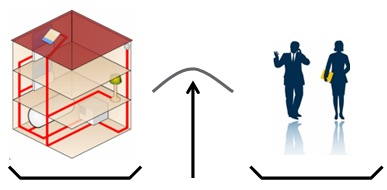Let me sum-up what was discussed in previous articles about intelligent building:
> no building automation ==> high energy consumption
> fully automatic building ==> occupants can’t adapt their environment to their comfort needs, feel “trapped” by the system and may thus become less productive
So is there a solution to reach both occupant comfort needs and energy efficiency ?
Yes, but the right balance is not easy to find …
Rule n°1: You have to trust people. But also lessen their imperfection.
Occupants or facility managers decide by themselves about their working (or living) environment conditions, but the action required to act on their environment choose be super-easy, and whenever it is repetitive an automatic function can be set-up to simplify occupants interaction.
Rule n°2: You have to make people responsible for their actions.
This can be done in many ways, but the best one I know is to show them the actual consequences of their choices. When I increase a temperature setting, if I see at once the impact on my energy consumption, I can decide knowingly. The same as the instant fuel consumption in cars may bring the driver to possibly decide to drive more smoothly.
This means you should have some energy consumption indicator in each building area: it is not a utopia, it is even quite easy to do, you just need to be very precise in the measurement plan of the building.
Rule n°3: You have to systematically compensate for absentmindedness
By programming an automatic change to “low consumption” mode when occupants are gone or when activity stops, and also by properly anticipating return to normal activity occupancy.
To illustrate these ideas in a private house:
> the house who decides for me if I’m warm or cold, if the stores should be lowered or the lighting reduced, if I should shut down my fan to make the smart grid happy, it’s not the future, it’s the nightmare.
> I am the one who switches on when I enter the living room; it’s the house which switches off when I go out. When I leave the house, a simple “I go out” button places automatically all the house in “low energy” mode
And it’s the same in offices, hotels, commercial and industrial buildings in general: it is good to automate machines as much as possible, but it is not the same for building controls.
In any case, I’m sure the solution is not the fully automatic building described in a previous article. I’m sure the best way is to find the best balance between simple people actions and automated functions.
If you have yourselves practical experiences which confirm or deny my ideas, I’m definitely interested!
James Cotte
